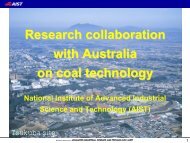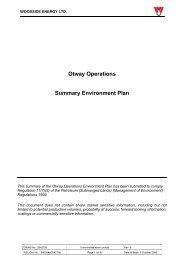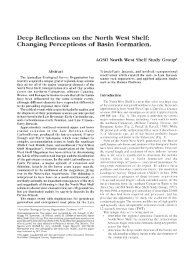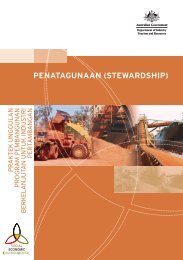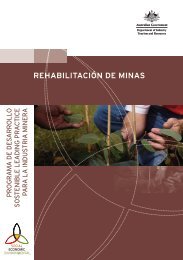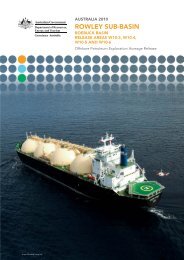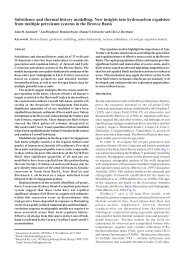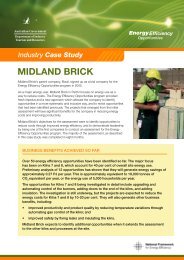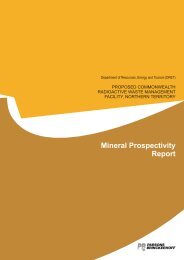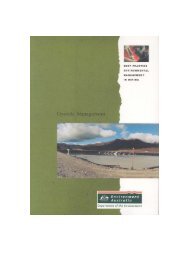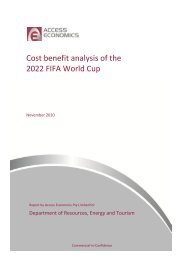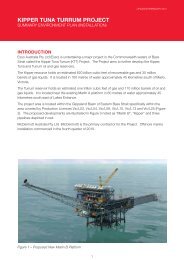- Page 1 and 2:
LEADING PRACTICE SUSTAINABLE DEVELO
- Page 3 and 4:
Disclaimer This publication has bee
- Page 5 and 6:
3.0 DEVELOPMENT AND CONSTRUCTION 61
- Page 7 and 8:
ACKNOWLEDGEMENTS The Leading Practi
- Page 9 and 10:
viii LEADING PRACTICE SUSTAINABLE D
- Page 12 and 13:
1.0 INTRODUCTION The Purpose and La
- Page 14 and 15:
Airborne Contaminants, Noise and Vi
- Page 16 and 17:
Water Management (LP Water) This ha
- Page 18 and 19:
Site water team Corporate managemen
- Page 20 and 21:
Sustainable Mining There is no one
- Page 22 and 23:
Mining the resource efficiently. Th
- Page 24 and 25:
Efficiency SUSTAINABLE MINING PRACT
- Page 26 and 27:
LOCATION: Vilabouly District, Savan
- Page 28 and 29:
Leading Practice The handbooks in t
- Page 30 and 31:
2.0 PRE-DEVELOPMENT: MINERAL EXPLOR
- Page 32 and 33:
The application of high standard en
- Page 34 and 35:
The Business Case for Sustainabilit
- Page 36 and 37:
The information obtained from these
- Page 38 and 39:
conditions are appropriate. In NSW,
- Page 40 and 41:
Such richness also brings challenge
- Page 42 and 43:
The dunefields of Shelburne Bay had
- Page 44 and 45:
Community Engagement in the Early S
- Page 46 and 47: Baseline studies and social impact
- Page 48 and 49: Upon completion of the study, resea
- Page 50 and 51: The scenarios envisaged for the Wat
- Page 52 and 53: 2. Reflections on the significance
- Page 54 and 55: Engaging with Indigenous communitie
- Page 56 and 57: Figure 2.9 - A New Township under C
- Page 58 and 59: Geochemical assessment aims to iden
- Page 60 and 61: Regardless of the project phase (ex
- Page 62 and 63: Evaluating Performance: Monitoring
- Page 64 and 65: For these reasons, it is important
- Page 66 and 67: Risk Management and Exploration Exp
- Page 68 and 69: Post-mining & closure Resource deve
- Page 70: level of family diversity was maint
- Page 73 and 74: Introduction The development and co
- Page 75 and 76: MINE: Mt Todd LOCATION: Near Kather
- Page 77 and 78: Airborne Contaminants, Noise and Vi
- Page 79 and 80: Biodiversity Management During Deve
- Page 81 and 82: Rather than taking a generic approa
- Page 83 and 84: Step 2: Working in collaboration On
- Page 85 and 86: course was designed to train and pr
- Page 87 and 88: Adjustments for changes in the mine
- Page 89 and 90: indicators of high importance durin
- Page 91 and 92: Operating major mining projects pre
- Page 93 and 94: the earliest stage of development,
- Page 95: Watercourse diversions In order to
- Page 99 and 100: tailings disposal techniques contin
- Page 101 and 102: Figure 4.2 - Predicted blast overpr
- Page 103 and 104: Responsible management of biodivers
- Page 105 and 106: Leading practice management of wate
- Page 107 and 108: MINE: Pierina Mine LOCATION: Distri
- Page 109 and 110: Weipa - a sustainable approach to t
- Page 111 and 112: Adopting the International Cyanide
- Page 113 and 114: Box 1: Major recent incidents invol
- Page 115 and 116: MINE: Chatree gold mine LOCATION: P
- Page 117 and 118: The audit outcomes also highlight t
- Page 119 and 120: Mercury for gold recovery in small/
- Page 121 and 122: Figure 4.9 - Geological control to
- Page 123 and 124: highest rating group for the whole
- Page 125 and 126: Figure 4.13 - Beverley uranium mine
- Page 127 and 128: from 2.5 - 3.0 tonnes/man-shift to
- Page 129 and 130: Figure 4.17 - Sunrise Dam TSF Taili
- Page 131 and 132: Dry stacking bauxite residue is now
- Page 133 and 134: Once the water is used underground
- Page 135 and 136: The Rio Tinto “Excellence in Wate
- Page 137 and 138: Background Image: Sourced from GOOG
- Page 139 and 140: Company policies and government reg
- Page 142 and 143: 5.0 MINE REHABILITATION AND CLOSURE
- Page 144 and 145: Closure involves the implementation
- Page 146 and 147:
Biodiversity and Closure Introducti
- Page 148 and 149:
e better than the high standard bei
- Page 150 and 151:
Figure 5.7 - Pasture and shelter tr
- Page 152 and 153:
The Argyle Diamonds case study (see
- Page 154 and 155:
support and on site accommodation a
- Page 156 and 157:
Having the right information to mak
- Page 158 and 159:
Figure 5.13 - Misima after rehabili
- Page 160 and 161:
In January 2011, the PNG government
- Page 162 and 163:
MINE: Former lignite mines LOCATION
- Page 164 and 165:
Fig 5.16: Former Minister Stein Coa
- Page 166 and 167:
Figure 5.19 - Rehabilitated mine si
- Page 168 and 169:
Figure 5.21 - Pit water treatment p
- Page 170 and 171:
Final Rehabilitation Rehabilitation
- Page 172 and 173:
Figure 5.23: Aerial view of Area 4
- Page 174 and 175:
Landform construction In general, e
- Page 176 and 177:
The Hsin-Chen Shan quarry terrain i
- Page 178 and 179:
Figure 5.29 - Spreading topsoil at
- Page 180 and 181:
Risk Management Risk at closure and
- Page 182 and 183:
During the 1980s and 1990s, a numbe
- Page 184 and 185:
An example of direct vegetation is
- Page 186:
Water Management Central to a mine
- Page 189 and 190:
Department of Resources, Energy and
- Page 192 and 193:
GLOSSARY AND ACRONYMS Abandoned min
- Page 194 and 195:
Biodiversity offsets Conservation a
- Page 196 and 197:
Cultural heritage Cultural heritage
- Page 198 and 199:
Engagement At its simplest, engagem
- Page 200 and 201:
High rate thickener A thickener thr
- Page 202 and 203:
NAPP Net Acid Producing Potential,
- Page 204 and 205:
Product stewardship This is perhaps
- Page 206 and 207:
Risk management process The risk ma
- Page 208 and 209:
Sustainable development Sustainable



